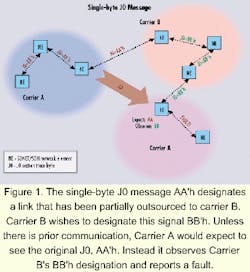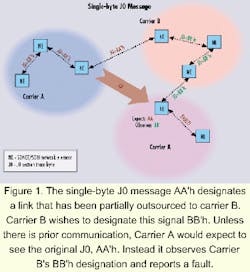Overhead transparency improves interoperability of optical networks
Extensions to SONET/SDH merge the benefits of optical networking with the familiarity of a known protocol.
Andrew Schmitt
Vitesse Semiconductor Corp.
Three years ago it appeared as if SONET/SDH was to be replaced by an all-optical future. Instead, SONET/SDH has undergone a renaissance of sorts, driven by IP- and ATM-over-SONET standardization, as well as innovative and aggressive equipment design. There are some deployments of IP over fiber, but in reality, these use a SONET/SDH framing structure with some of the management functions disabled. The wide availability of chipsets and firmware, entrenched carrier software infrastructure, and well-understood and documented standards make SONET/SDH a safe choice for future optical-networking deployment.
The term "optical networking" is so widely used that it needs to be accurately defined. Optical networking in its ideal form is the ability to "nail up" or "tear down" a connection capable of reliably delivering protocol- or rate-independent service between any two network nodes. Light goes in at point A and emerges at point B error-free and without apparent modification. A client can use this connection to transmit at any frequency, with any protocol, and without knowledge of the topology of the optical connection or its protection scheme. A true optical network provides a very valuable feature set by adding manageability, reliability, and connection flexibility to a lambda.A rate- and protocol-independent network is attractive because it provides the ideal transport layer for any type of client that an operator wishes to use. An optical network provides connections that are protocol- and rate-independent, allowing any type of client to pass through-a trait called transparency. Unfortunately, the same characteristics that make a transparent network attractive also complicate its realization. Thus, the "Dilemma of Transparency": Without knowledge of the protocol and the bit rate being transmitted through the network, it is impossible to provide manageability, reliability, and connection flexibility.
Without accessing the protocol, it is difficult to provide the quality-of-service (QoS) guarantees that customers demand. A commonly heard mantra among network engineers is, "If we can't manage it, we won't deploy it. Period." That means the Dilemma of Transparency must be resolved before protocol- and rate-independent networks are deployed.
One possible solution requires that the client provide rate and protocol information to the network operating system dynamically; thus, equipment could be provisioned on the fly to monitor the client du jour. Unfortunately, that places the burden of monitoring all protocols in every piece of equipment. That also would prevent the deployment of new protocols into the installed base.
Compounding the problem is the fact that the operations, administration, maintenance, and provisioning (OAM&P) structure would be forced to consolidate a variety of client-specific telemetry such as errored 10B words for Fibre Channel and Gigabit Ethernet or parity errors for SONET/ SDH. Some protocols lack management equivalency, i.e., there is no equivalent for a trace ID in some protocols, which is a vital function in the wide area network (WAN). That places the management burden on the already balkanized network-management software by forcing it to deal with an unbounded and non-uniform set of QoS parameters.
These problems prevent a bulletproof implementation of a protocol- and rate-independent optical network. Solutions include protocols such as the ITU G.709 OTN frame, which is generating a large amount of interest because it solves all the previously mentioned problems by wrapping all clients in a single, homogeneous container. However, there are alternatives to using a digital wrapper for carriers and equipment manufacturers that would rather improve and extend the existing SONET/SDH protocol, several of which are already deployed today.
The Dilemma of Transparency has caused the optical-networking world to evolve around SONET/SDH, where various protocols are adapted into the SONET/SDH payload envelope. Originally designed to carry voice, SONET/SDH now carries ATM cells and IP packets, plus many proprietary implementations for carrying various other clients. Soon, Ethernet over SONET/SDH will be codified, and that is likely to prove very popular for data-center connectivity through the WAN.
SONET/SDH has several advantages over the G.709 digital wrapper, such as an installed base, well-understood and documented specifications, widely available components, and most importantly, the ability to groom at a tributary level. Connections can be established at the STS-1/STM-1 level, whereas G.709 restricts to wavelength connections. SONET/SDH's ability to groom at a tributary level allows carriers to avoid "burning a wave" or wasting a 10-Gbit/sec wavelength by transmitting only 2.5 Gbits/sec worth of data. SONET/SDH allows bandwidth to be divided among several users.
It is safe to assume that SONET/ SDH will continue to persist in the WAN, and most clients will be adapted into the payload of this protocol. Optical networking will be client-independent, so long as that client is adapted into SONET/SDH or G.709.
The major problem with SONET/ SDH as an optical-networking protocol is the inherent lack of transparency in its protocol stack. Specifically, SONET/SDH does not allow two carriers to mesh their networks without interrupting each other's management structure. The rigid section, line, and path-termination architecture assumes that the end-to-end link is managed entirely by one carrier, which is no longer the case. G.709 addresses this with the use of a "stackable" OAM&P structure, where management information is "pushed" off an internal stack as it transits several domains. Consider the benefits of bringing protocol transparency to SONET/SDH-a transparent network compatible with the existing infrastructure.
Transparency allows network carriers to deploy an optical network that allows them to provide and manage connections without regard to the type of equipment utilizing the network. This feature enables them to provide optical connections and act as a commodity bandwidth supplier. Revenue is generated by "bandwidth brokering," i.e., leasing an optical connection to an end customer (typically another carrier) that will incorporate the new link as another connection within its network. Alternatively, two carriers may trade bandwidth, each supplementing exhausted routes with ones that are under-utilized by the other. It's even possible to envision a future where lambda kilometers are bought and sold on the commodity exchanges of the world.Turning bandwidth into a brokered commodity requires certain improvements. Transaction costs associated with transferring rights to a particular connection must be minimized, and reconfiguration of the network must be quick and seamless to allow flexible lease terms: 15 min for an enterprise data-center backup, 3 hrs for a sports telecast, and one year for a backbone capacity upgrade. Connections must have been guaranteed with uniform QoS. Most importantly, consumers of commodity bandwidth need to integrate new connections into the larger network without knowledge of the supplier's network or OAM&P structure, i.e., protocol transparency.
Protocol transparency allows bandwidth consumers to overlay their own preferred OAM&P structure, such as SONET/SDH, and make the leased link look like a new segment of their own network. The leased link is a "nested domain" within the customer's larger network. At the same time, the bandwidth vendor needs to monitor and guarantee the contractual QoS parameters agreed upon at the commodity exchange and manage the many different links that have been leased to countless other customers. In effect, two customers want management information to transit the same link, and both want unrestricted access to the protocol overhead.
The SONET/SDH protocol was not designed to support nested domains and allow carriers to mesh their networks together. Historically, the unit of handoff was once DS-1 and is now DS-3. But even that did not allow one carrier's management data to tunnel through another's network. SONET/ SDH management information contained in the SONET/SDH overhead is replaced when a signal leaves one carrier's domain and crosses into another. This information includes bytes for bit error rate (B1/2/3), section and path trace (J0 and J1), data communication (D1-D12), orderwire, and, perhaps, proprietary bytes. The original carrier will see that the other carrier providing the nested domain has substituted its own overhead information in place of the original bytes. The nested domain is opaque to the bandwidth customer's SONET/ SDH OAM&P information.
This problem prevents carriers from easily swapping bandwidth, since it forces them to accept management holes within their network and greatly complicates their task of guaranteeing QoS over leased bandwidth.
Consider the example in Figure 1. Both the bandwidth supplier and customer need to manage the connection matrix of their SONET/SDH network using the J0 section trace byte. The J0 byte contains a repeating 1-, 16-, or 64-byte message that acts as a virtual SONET/SDH name tag. Observation of this value allows the provisioning of add/drop multiplexers (ADMs) and other SONET/SDH and wavelength grooming resources to verify they are configured properly.
Carrier A (bandwidth customer) hands off a SONET signal with the 1-byte tag (AA'h) to Carrier B (bandwidth supplier), expecting that it will return to its network at another node. However, Carrier B wished to designate this signal as (BB'h) and replaces the contents of the J0 byte with its designation. When the signal returns to Carrier A, it is now marked (BB'h). Unless Carrier A makes arrangements within its network operating system in advance, it appears that signal (AA'h) has disappeared and been replaced by signal (BB'h), indicating a misconnection fault in their network. This misconnection fault is in error, but wreaks havoc with carrier A's OAM&P infrastructure.
Requiring carriers A and B to communicate the expected changes to the J0 section trace in advance is difficult, especially if Carrier B decides to subcontract a portion of the link to a new, third carrier. There is no electronic means to communicate this information-it must be done manually. A blind handoff is needed from carrier to carrier to realize a true commodity bandwidth model, which requires that the (AA'h) value received by Carrier B must be restored when the signal is returned to Carrier A, and it needs to take place in an automated fashion. That allows the leased link or nested domain to appear as a contiguous part of Carrier A's network.
Consider the example in Figure 2. If the J0 message received by Carrier B is saved in an unused part of the SONET/SDH overhead, than Carrier B can safely replace the (AA'h) message with its own (BB'h) byte. This transparent mapping function is performed at ingress to Carrier B's network. Each network node within Carrier B's network can transparently pass the in-band J0 byte that occupies a byte of the unused overhead. The original (AA'h) message would be transparently demapped from its known overhead location and restored to the J0 byte position when the signal exits Carrier B's network.
The same technique can be applied to other bytes, such as detected parity errors or the DCC (data-communication channel) bytes for intra-equipment communication. That allows the OAM&P information to be received by carrier A exactly as it was originally transmitted and allows carrier B to use the SONET/SDH overhead in the standard manner. Each network is independently manageable by independent carriers, but the hardware is intelligent enough to provide SONET/SDH protocol transparency. The client- and protocol-independent characteristics of optical networking can be combined with a well-known and widely deployed protocol.
This is a simplification of the hardware techniques involved, and concerns about using unused portions of the SONET/SDH overhead are recognized. Such a feature would allow some SONET/SDH signals to be designated as transparent "wavelength" tributaries, while others could continue to be groomed at the STS-1/STM-1 level.
The emerging market for bandwidth brokering will not tolerate carriers making manual adjustments to their network operating system to provide the required SONET/SDH protocol transparency. Some form of automated solution is needed to provide the transparency of an optical network and the benefits it brings, while retaining the protocol tributary grooming infrastructure that carriers have come to favor and continue to deploy-SONET/SDH.
Andrew Schmitt is product marketing manager at Vitesse Semiconductor Corp. (Camarillo, CA). He can be reached at [email protected].


